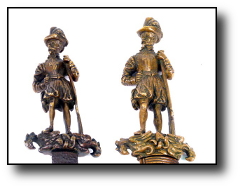|
Two French Military Officer
Daggers, Circa 1560
|
|
The bronze hilts of two
daggers are shown at the
right. They are almost
identical, but it`s likely that the one on the
left side of the photo spent most of the last 450 years
buried in South Carolina near Port Royal Sound.
It was unearthed by Jack
Williams in the early 1960s.
The other he purchased from a
private collection over a
decade later. This second
dagger still has its
original scabbard. Williams
believed that the excavated
dagger came from the French
settlement of Charlesfort, or
from the Spanish occupation
that followed called Santa
Elena.
|

|
|
Charlesfort and Santa
Elena
|
In May of 1562 French
Huguenots began building an
outpost on what is today
Parris Island, South
Carolina. The Island is
located in Port Royal Sound.
The Huguenots were
protestants seeking refuge
from religious persecution in
France and hoping to found a
protestant community in the
new world. The expedition was
lead by a Norman navigator,
Jean Ribault. Ribault named
the outpost Charlesfort
(Charles forte) after Charles
IX. On June 11, 1562 Ribault
departed leaving behind
twenty-six men. He planned to
return before the end of the
year with supplies and
additional settlers. When he
didn`t return, Charlesfort
was abandoned in April of
1563. (1)
In 1566 the Spanish
explorer Pedro Menendez de
Aviles founded Santa Elena
on the site of Charlesfort.
Menendez intended Santa
Elena to be the permanent
capital of Spanish Florida.
Native tribes attacked and
burned the settlement and
its fort San Felipe, in
1567. A year later the
Spanish rebuilt the
settlement and a new fort
which they called Fort San
Marcos. Forced to repel
repeated native attacks,
the Spanish abandoned the
site in 1587. (2)
|
|
Detailed Description
|
Both daggers have cast bronze
hilts with steel blades. The
period clothing and armor of
the French officer that forms
each hilt indicates their
origin. The officer is
leaning on matchlock, his left
hand wrapped around its
muzzle. His right hand rests
on a dagger in a leather
carry which was called a
frog. Below the frog hangs a
pouch to hold balls and cloth
patches, a large flask to
hold priming powder, and
several small flasks to hold
premesured single charges.
The scabbard is also of cast
bronze with classical motifs
in high relief. Ornate
designs like these would have
been expensive, so the
daggers must have belonged
to men who were well off.
(3)
|
|
Overview
|
|
Type:
|
16th Century Dagger
|
|
Style:
|
Quillon
|
|
Country:
|
France
|
|
Overall Length:
|
12 inches
|
|
Overall Width:
|
2 5/8 inches
|
|
Hilt Length:
|
5 1/16 inches
|
|
Blade Length:
|
6 15/16 inches
|
|
Weight:
|
14 1/4 ounces w/o
scabbard
|
|
Grip:
|
French Officer, Cast
bronze
|
|
Scabbard:
|
8 1/4 by 1 1/4, 6oz
|
|
|
|
References
(1) The History of
Charlesfort, University of North
Carolina, The South Carolina
Institute of Archaeology and
Anthropology, and The Institute
for Southern Studies
(2) Santa Elena
History, see the First and Second
Spanish Occupations,
University of South Carolina, The
South Carolina Institute of
Archaeology and Anthropology, and The
Institute for Southern
Studies
(3)
Powder Horns in the Southern
Tradition, see Plate III on page 11,
Museum of Florida History (1985),
Powder Horns Exhibit Team Curator:
Patricia R. Wickman,
|
|
|